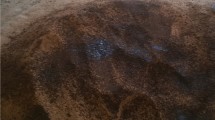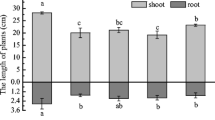Abstract
Phytoremediation is a cost-effective and environmentally friendly technology using plants for the cleanup of both inorganic and organic contaminated sites. In this study, a pot culture experiment has been conducted for 180 days in a greenhouse to examine the capability of Koelreuteria paniculata on pyrene (Pyr) dissipation in contaminated soil. Three treatments were employed and they were: (1) polluted soil with K. paniculata fine roots addition (T1), (2) polluted soil with planted seedlings (T2), and (3) polluted soil (C). Results showed Pyr concentration in soils was reduced by 21.4, 36.2, and 86.4% by natural losses, fine roots addition, and planted K. paniculata treatments, respectively, meaning plants substantially enhanced the dissipation of Pyr from soil. Cultivated K. paniculata seedlings significantly increased soil total nitrogen (TN), total organic carbon, dissolved organic carbon (DOC), and microbial biomass carbon, but not total phosphorus, when compared to the control. The removal efficiency of Pyr was lower in the adding of fine roots treatment than in the planted K. paniculata treatment. The principal component analysis indicated the promotional dissipation of Pyr in soil by planted K. paniculata was likely attributed to increased microbial quantity and activity, DOC, and TN content in the rhizosphere. Our results suggest that K. paniculata is a suitable plant species used in phytoremediation for Pyr-contaminated soils and the efficiency on the dissipation of Pyr is considerably enhanced using living plants than adding dead organic matters. The study provided a reference for the application of K. paniculata in the remediation of Pyr-contaminated soil.






Similar content being viewed by others
References
Abdel-Shafy, H. I., & Mansour, M. S. M. (2016). A review on polycyclic aromatic hydrocarbons: source, environmental impact, effect on human health and remediation. Egyptian Journal of Petroleum, 25(1), 107–123.
Badri, D. V., & Vivanco, J. M. (2009). Regulation and function of root exudates. Plant Cell & Environment, 32(6), 666–681.
Bisht, S., Pandey, P., Bhargava, B., Sharma, S., Kumar, V., & Sharma, K. D. (2015). Bioremediation of polyaromatic hydrocarbons (PAHs) using rhizosphere technology. Brazilian Journal of Microbiology, 46(1), 7–21.
Cheema, S. A., Imran, K. M., Shen, C., Tang, X., Farooq, M., Chen, L., Zhang, C. K., & Chen, Y. X. (2010). Degradation of phenanthrene and pyrene in spiked soils by single and combined plants cultivation. Journal of Hazardous Materials, 177, 384–389.
D'Orazio, V., Ghanem, A., & Senesi, N. (2013). Phytoremediation of pyrene contaminated soils by different plant species. CLEAN-Soil, Air, Water., 41(4), 377–382.
Gao, Y., Wu, S. C., Yu, X. Z., & Wong, M. H. (2010). Dissipation gradients of phenanthrene and pyrene in the rice rhizosphere. Environmental Pollution, 158(8), 2596–2603.
Guo, M. X., Gong, Z. Q., Miao, R. H., Su, D., Li, X. J., Jia, C. Y., & Zhuang, J. (2017). The influence of root exudates of maize and soybean on polycyclic aromatic hydrocarbons degradation and soil bacterial community structure. Ecological Engineering, 99, 22–30.
Haichar, F. E. Z., Santaella, C., Heulin, T., & Achouak, W. (2014). Root exudates mediated interactions belowground. Soil Biology & Biochemistry, 77(7), 69–80.
Han, X. M., Liu, Y. R., Zhang, L. M., & He, J. Z. (2015). Insight into the modulation of dissolved organic matter on microbial remediation of PAH-contaminated soils. Microbial Ecology, 70(2), 400–410.
Hinsinger, P., Plassard, C., Tang, C., & Jaillard, B. (2003). Origins of root-mediated ph changes in the rhizosphere and their responses to environmental constraints: a review. Plant & Soil, 248(1–2), 43–59.
Kemp, P. R., Reynolds, J. F., Virginia, R. A., & Whitford, W. G. (2003). Decomposition of leaf and root litter of Chihuahuan desert shrubs: effects of three years of summer drought. Journal of Arid Environments, 53(1), 21–39.
Kim, K. H., Jahan, S. A., Kabir, E., & Brown, R. J. (2013). A review of airborne polycyclic aromatic hydrocarbons (PAHs) and their human health effects. Environment International, 60(5), 71–80.
Kuiper, I., Lagendijk, E. L., Bloemberg, G. V., & Lugtenberg, B. J. (2004). Rhizoremediation: a beneficial plant-microbe interaction. Molecular Plant-Microbe Interactions, 17(1), 6–15.
Kumar, V., Saikia, J., Barik, & Das, T. (2017). Effect of integrated nutrient management on soil enzymes, microbial biomass carbon and microbial population under okra cultivation. International Journal of Biochemistry Research & Review, 20(4), 1–7.
Lee, S. H., Lee, W. S., Lee, C. H., & Kim, J. G. (2008). Degradation of phenanthrene and pyrene in rhizosphere of grasses and legumes. Journal of Hazardous Materials, 153(1), 892–898.
Leigh, M. B., Fletcher, J. S., Fu, X., & Schmitz, F. J. (2002). Root turnover: an important source of microbial substrates in rhizosphere remediation of recalcitrant contaminants. Environmental Science & Technology, 36(7), 1579–1583.
Liang, X. C., Yan, W. D., Tian, D. L., Zhu, F., Wang, G. J., & Zheng, W. (2012). Phytoremediation of polycyclic aromatic hydrocarbons in soils by Cinnamomum camphora and impact factors. Journal of Central South University of Forestry & Technology, 32(12), 177–180 (in Chinese).
Lin, C. F., Yang, Y. S., Guo, J. F., Chen, G. S., & Xie, J. S. (2010). Fine root decomposition of evergreen broadleaved and coniferous tree species in mid-subtropical China: dynamics of dry mass, nutrient and organic fractions. Plant & Soil, 338(1–2), 331–327.
Liste, H. H., & Alexander, M. (2000). Accumulation of phenanthrene and pyrene in rhizosphere soil. Chemosphere, 40(1), 11–14.
Luo, Y. Q., Zhao, X. Y., Li, Y. Q., Zuo, X. A., Jie, L., & Tao, W. (2016). Root decomposition of Artemisia halodendron, and its effect on soil nitrogen and soil organic carbon in the horqin sandy land, northeastern China. Ecological Research, 31(4), 535–545.
Matsodoum Nguemté, P., Djumyom Wafo, G. V., Djocgoue, P. F., Kengne Noumsi, I. M., & Wanko Ngnien, A. (2018). Potentialities of six plant species on phytoremediation attempts of fuel oil-contaminated soils. Water, Air, & Soil Pollution, 229(3), 88.
Miya, R. K., & Firestone, M. K. (2001). Enhanced phenanthrene biodegradation in soil by slender oat root exudates and root debris. Journal of Environmental Quality, 30(6), 1911–1918.
Moretto, A. S., Distel, R. A., & Didoné, N. G. (2001). Decomposition and nutrient dynamic of leaf litter and roots from palatable and unpalatable grasses in a semi-arid grassland. Applied Soil Ecology, 18(1), 31–37.
Mueller, K. E., & Shann, J. R. (2006). PAH dissipation in spiked soil: impacts of bioavailability, microbial activity, and trees. Chemosphere, 64(6), 1006–1014.
Nguyen, C. (2003). Rhizodeposition of organic C by plant: mechanisms and controls. Agronomie, 23, 375–396.
Parrish, Z. D., Banks, M. K., & Schwab, A. P. (2005). Effect of root death and decay on dissipation of polycyclic aromatic hydrocarbons in the rhizosphere of yellow sweet clover and tall fescue. Journal of Environmental Quality, 34(1), 207–216.
Salt, D. E., Smith, R. D., & Raskin, I. (1998). Phytoremediation. Annual Review Plant Physiology and Plant Molecular Biology, 49(49), 643–668.
Setiawati, T. C. (2014). Correlations between soil microbe and soil chemical properties in limestone mining area: case study at Southern Jember Indonesia. International Conference on Chemical, Environment & Biological Sciences, Sept. 17–18. Kuala Lumpur (Malaysia). https://doi.org/10.15242/IICBE.C914048.
Shahsavari, E., Adetutu, E. M., Taha, M., & Ball, A. S. (2015). Rhizoremediation of phenanthrene and pyrene contaminated soil using wheat. Journal of Environmental Management, 155, 171–176.
Shaw, L. J., & Burns, R. G. (2003). Biodegradation of organic pollutants in the rhizosphere. Advances in Applied Microbiology, 53, 1–60.
Shen, H. Z., Huang, Y., Wang, R., Zhu, D., Li, W., Shen, G. F., Wang, B., Zhang, Y. Y., Chen, Y. C., Lu, Y., Chen, H., Li, T. C., Sun, K., Li, B. G., Liu, W. X., Liu, J. F., & Tao, S. (2013). Global atmospheric emissions of polycyclic aromatic hydrocarbons from 1960 to 2008 and future predictions. Environmental Science & Technology, 47(12), 6415–6424.
Shi, S., Richardson, A. E., O'Callaghan, M., Deangelis, K. M., Jones, E. E., Stewart, A., Firestone, M. K., & Condron, L. M. (2011). Effects of selected root exudate components on soil bacterial communities. FEMS Microbiology Ecology, 77(3), 600–610.
Sun, T. R., Cang, L., Wang, Q. Y., Zhou, D. M., Cheng, J. M., & Xu, H. (2010). Roles of abiotic losses, microbes, plant roots, and root exudates on phytoremediation of PAHs in a barren soil. Journal of Hazardous Materials., 176, 919–925.
Tejeda-Agredano, M. C., Gallego, S., Vila, J., Grifoll, M., Ortega-Calvo, J. J., & Cantos, M. (2013). Influence of the sunflower rhizosphere on the biodegradation of PAHs in soil. Soil Biology & Biochemistry, 57(3), 830–840.
Tong, J., Xiang, W. H., Liu, C., Lei, P. F., Tian, D. L., Deng, X. W., & Peng, C. H. (2012). Tree species effects on fine root decomposition and nitrogen release in subtropical forests in southern China. Transactions of the Botanical Society of Edinburgh, 5(3), 323–331.
Wang, W. J., Baldock, J. A., Dalal, R. C., & Moody, P. W. (2004). Decomposition dynamics of plant materials in relation to nitrogen availability and biochemistry determined by NMR and wet-chemical analysis. Soil Biology & Biochemistry, 36(12), 2045–2058.
Wilcke, W. (2000). Polycyclic aromatic hydrocarbons (PAHs) in soil—a review. Journal of Plant Nutrition and Soil Science, 163(3), 229–248.
Xu, W. Q., Liu, J. X., Liu, X. Z., Li, K., Zhang, D. Q., & Yan, J. H. (2013). Fine root production, turnover, and decomposition in a fast-growth eucalyptus urophylla, plantation in southern China. Journal of Soils & Sediments, 13(7), 1150–1160.
Yan, J., Wang, L., Fu, P. P., & Yu, H. (2004). Photomutagenicity of 16 polycyclic aromatic hydrocarbons from the US EPA priority pollutant list. Mutation Research, 557(1), 99–108.
Yoshitomi, K. J., & Shann, J. R. (2001). Corn (Zea mays L.) root exudates and their impact on 14C-pyrene mineralization. Soil Biology & Biochemistry, 33(12), 1769–1776.
Yu, X. Z., Wu, S. C., Wu, F. Y., & Wong, M. H. (2011). Enhanced dissipation of PAHs from soil using mycorrhizal ryegrass and PAH-degrading bacteria. Journal of Hazardous Materials, 186(2–3), 1206–1217.
Zhang, X. Q., & Wu, K. H. (2001). Fine-root production and turnover for forest ecosystems. Scientia Silvae Sinicae, 37(3), 126–138 (in Chinese).
Zhang, X. Q., Wu, K. H., & Murach, D. (2000). A review of methods for fine-root production and turnover of trees. Acta Ecologica Sinica, 20(5), 875–883 (in Chinese).
Zhang, J. Y., Yu, F., & Yu, Y. C. (2017). Content and source apportionment of polycyclic aromatic hydrocarbons in surface soil in major areas of China. Ecology and Environmental Sciences, 26(6), 1059–1067 (in Chinese).
Zhu, F., Tian, D. L., Yan, W. D., Liang, X. C., & Wang, G. J. (2011). Phytoremediation of polycyclic aromatic hydrocarbons contaminated soils by Koelreuteria bipinnata. Journal of Northwest Forestry University, 26(1), 52–55 (in Chinese).
Acknowledgments
The authors thank the Key Research and Development Project of Hunan Province (2017NK2171), Ecology Discipline and Nature Science Foundation of Hunan Provincial Innovative Research Team (2013) for financial support.
Author information
Authors and Affiliations
Corresponding author
Additional information
Publisher’s Note
Springer Nature remains neutral with regard to jurisdictional claims in published maps and institutional affiliations.
Rights and permissions
About this article
Cite this article
Liu, T., Zhu, F., Yan, W. et al. Assessment of Koelreuteria paniculata Seedling for Phytroremediation of Pyrene-Contaminated Soils. Water Air Soil Pollut 229, 396 (2018). https://doi.org/10.1007/s11270-018-4044-2
Received:
Accepted:
Published:
DOI: https://doi.org/10.1007/s11270-018-4044-2




